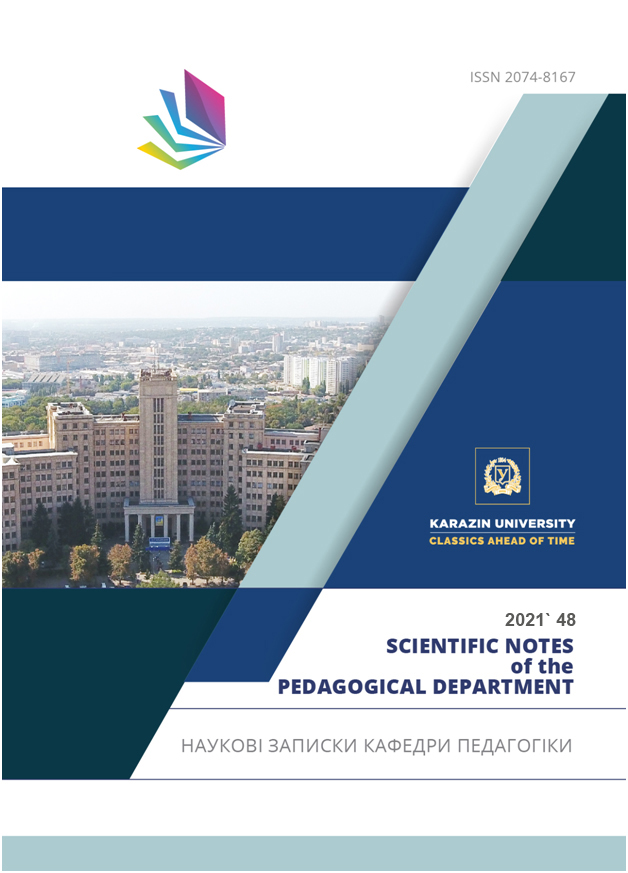Verbal and non-verbal methods of activation of cognitive behavior of educational applicants in the process of learning foreign languages
Abstract
The article considers the analysis of the use of verbal and non-verbal methods in the process of learning foreign languages. The relevance of this research is connected to the fact that the learning of foreign languages in the modern world is becoming advanced and progressive, so there is an urgent need to study the effectiveness of methods of activation of students` cognitive activity. The article highlighted such concepts as "verbal methods", "non-verbal methods", "interactive technologies of learning foreign languages", "The Silent Way", "the 25th frame effect" and "Schechter`s method", and also considered the features of various technologies and their effectiveness. This article highlights the results of a survey among students of the Faculty of Foreign Languages, V.N. Karazin Kharkiv National University, in which they had to answer twelve questions about the relevance of using the methods presented in the article and their attitude to them. Students shared their own experience and expressed their view on the feasibility of their use in the future in their professional activity. Based on the results of the survey, the authors of the research highlighted the most important issues regarding the use of interactive technologies in the process of learning foreign languages.
Downloads
References
/References
Zhernovnykova, O. A., Peretiaha, L. Y., Kovtun, A. V., Korduban, M. V., Nalyvaiko, O. O., & Nalyvaiko, N. A. (2020). Tekhnolohiia formuvannia tsyfrovoi kompetentnosti maibutnikh uchyteliv zasobamy heimifikatsii [The technology of prospective teachers’ digital competence formation by means of gamification]. Information Technologies and Learning Tools, 75(1), 170-185. https://doi.org/10.33407/itlt.v75i1.3036 (in Ukrainian)
Piz, A. (2000) Yazy`k telodvizhenij: kak chitat` my`sli drugikh po ikh zhestam [Body language. How to read the thoughts of others by their gestures]. St. Petersburg: Gutenberg Publishing House (in Russion)
Khmilʹ, F. (2004). Dilove spilkuvannya : navch. posib. [Business communication: textbook]. Kyiv: Akademvydav. (in Ukrainian)
Shekhter, I. Yu. (2005). Zhivoj yazik [Live language]. Moscow: Rector (in Russion).
Ї
Eriksson, Rigmor & Annesofi, Jakobsson (2001). Språk för livet idébok i språkdidaktik. Stockholm: Liber AB. (in Swedish)
Gattegno, C. (1963). Teaching foreign languages in schools: The silent way. New York: Educational Solutions World Inc. (in English)
Nalyvaiko, O., Vakulenko, A., & Zemlin, U. (2020). The use of the mobile application “Drops” in the process of learning foreign languages. Electronic Scientific Professional Journal “Open Educational e-Environment of Modern University”, (8), 107-120. https://doi.org/10.28925/2414-0325.2020.8.10 (in English)
Oxford Advanced Learner’s Dictionary (2011). Oxford Advanced Learner’s Dictionary. Oxford University Press, New 8th Edition. (in English)
Richards, J. C., & Rodgers, T. S. (2001). Approaches and methods in language teaching. New York, NY: Cambridge University Press. (in English)
Richards, J. C. (2013). Curriculum Approaches in Language Teaching: Forward, Central,and Backward Design. RELC Journal, 44(1), 5-33. (in English)
Tornberg, U. (2000). Om språkundervisning i mellanrummet – om talet om "kommunikation" och "kultur" i kursplaner och läromedel från 1962 till 2000.Uppsala: Uppsala universitet. (in Swedish)
Vicary, J. M. (1951). How psychiatric methods can be applied to market research. Printers’ Ink, 235(6), 39-48. (in English)
Жерновникова О. А., Перетяга Л. Є., Ковтун А. В., Кордубан М. В., Наливайко О. О., Наливайко Н. А.. Технологія формування цифрової компетентності майбутніх учителів засобами гейміфікації. Інформаційні технології і засоби навчання. 2020. 75(1). C. 170-185. https://doi.org/10.33407/itlt.v75i1.3036
Пиз А. Язык телодвижений: как читать мысли других по их жестам. Санкт-Петербург : Изд. дом Гутенберг, 2000. 185 с.
Хміль. Ф. Ділове спілкування : навч. посіб. Київ : Академвидав, 2004. 280 с.
Шехтер И. Ю. Живой язык. Москва : Ректор, 2005. 240 с.
Eriksson R. & Annesofi J. Språk för livet idébok i språkdidaktik. Stockholm: Liber AB. 2001.
Gattegno C. Teaching foreign languages in schools: The silent way. New York : Educational Solutions World Inc. 1963. 192 p.
Nalyvaiko O., Vakulenko A., & Zemlin U. The use of the Mobile Application «DROPS» in the Process of Learning Foreign Languages. Electronic Scientific Professional Journal «Open Educational E-Environment Of Modern University». 2020. (8). pp. 107-120. https://doi.org/10.28925/2414-0325.2020.8.10
Oxford Advanced Learner’s Dictionary, Oxford University Press, New 8th Edition, 2011.
Richards J. C., & Rodgers T. S. Approaches and methods in language teaching. New York, NY : Cambridge University Press. 2001.
Richards J. C. Curriculum Approaches in Language Teaching: Forward, Central,and Backward Design. RELC Journal. 2013. 44(1) pp. 5-33
Tornberg U. Om språkundervisning i mellanrummet - om talet om "kommunikation" och "kultur" i kursplaner och läromedel från 1962 till 2000. Uppsala: Uppsala universitet. 2000.
Vicary J. M. How psychiatric methods can be applied to market research. Printers’ Ink. 1951. 235(6). pp.39-48

